
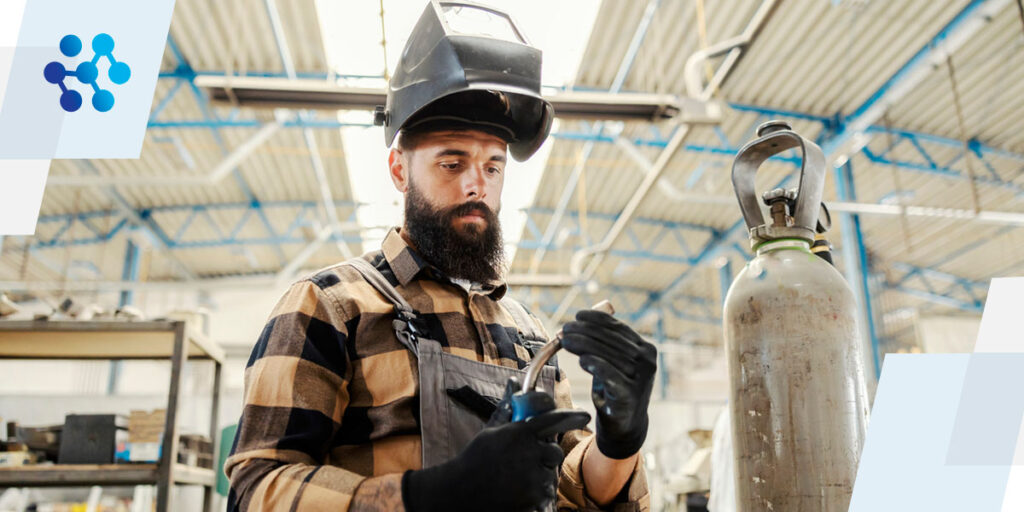
Gas welding, also known as oxyacetylene welding, is popular among welders due to its versatility, speed and ability to produce high-quality welds on various metals, like aluminum and steel. It involves using heat from burning fuels like acetylene to cut and join metals. This guide will discuss the essential gas welding tools and equipment welders should use on a daily basis, along with oxyacetylene welding best practices.
Here are four pieces of equipment you need for oxyacetylene welding:
An oxy-fuel welding torch has many functions. First, it’s used to produce a controlled flame when welding. You can also use it to mix acetylene and oxygen properly before release. Finally, it can prevent flashbacks and help welders obtain a specific flame.
There are two types of oxy-fuel welding torches. The first is the equal-pressure torch, also known as a medium- or balanced-pressure torch. The second is the injector torch, also known as a low-pressure torch.
Equal-pressure torches keep the fuel gas and oxygen pressure equal. The general operating pressure can vary depending on the torch you use. Injection pressure torches typically have a fuel-gas pressure of 1 pound per square inch or less. The oxygen pressure can range between 10-40 pounds per square inch, depending on the size of the torch’s tip. A high-pressured oxygen torch can generate enough suction to draw the fuel gas into the mixing head.
Gas cylinders are made of heat-treated drawn steel and are used to store gas at high pressure. They have high-pressure valves and valve protector caps located at the top. There are acetylene and oxygen cylinders, which are identified by their colors, markings or size. Acetylene cylinders are maroon-colored and short in size. Oxygen cylinders are often painted black.
Regulators are used to reduce and maintain constant pressure from the cylinders, regardless of pressure variation at the source. Regulators also help you adjust the gas pressure to the torch. You can change the pressure by turning the handle on the regulator. There are typically two types of pressure regulators — single-stage and double-stage.
In single-stage regulators, the gas pressure from the source is directly reduced to the torch’s working pressure in one stage. It usually has a floating valve, balancing springs and a diaphragm enclosed in a suitable housing. Double-stage regulators reduce pressure in two stages. There are two independent diaphragms and valve assemblies that ensure a more constant pressure delivery.
Pressure gauges are also crucial on gas cylinders. They register the gauge pressure, which is the difference between the interior and exterior pressure.
Hoses help transport gas from the cylinder regulator to the torch. Two hoses are required to carry acetylene and oxygen separately. Just like gas cylinders, they are usually color-coded. Fittings ensure the hoses are well-secured. You must ensure your fittings are free from grease or oil to avoid explosions or other hazards.
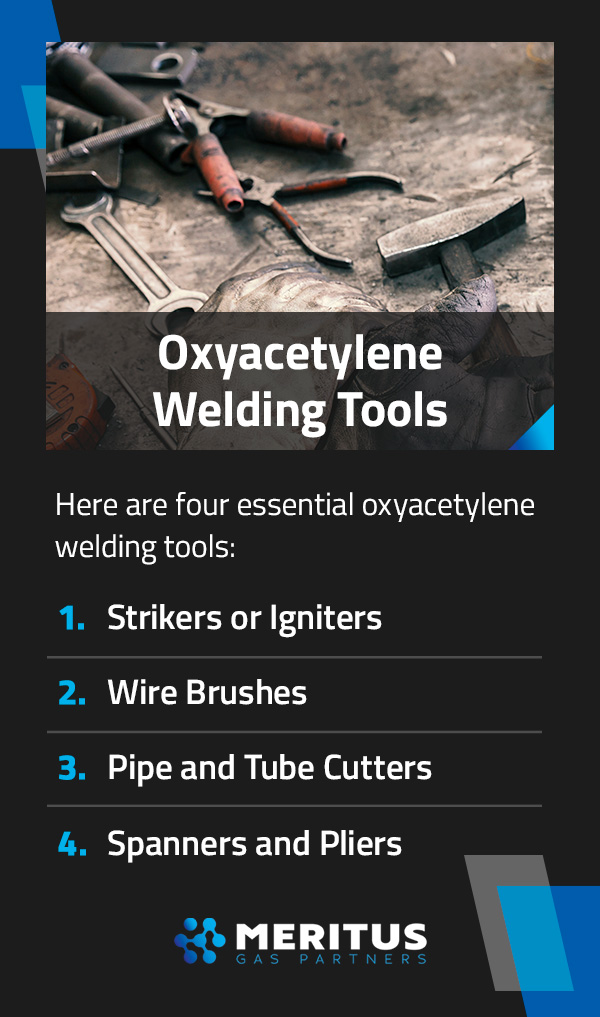
Here are four essential oxyacetylene welding tools:
Strikers or igniters create a spark to ignite a gas torch or burner. There are different types of strikers, including flint lighters, electronic lighters and piezo lighters. Flint lighters use pieces of flint scraped against a metal wheel to produce sparks. Electronic strikers rely on battery-powered circuits to generate high-voltage arcs between two electrodes. Piezo lighters use a spring-loaded hammer to strike a piezoelectric crystal to create an electric spark.
The primary purpose of a welding brush is to clean metal surfaces. You can use it before welding to remove rust, mill scale, paint and other contaminants that can interfere with welding. After welding, you can use wire brushes to clean slag off the weld’s surface. Slag is layers of impurities created from the weld flux that protect the weld from atmospheric contamination.
Wire brushes may be used by hand or attached to a power tool. Different materials are used to make the bristles of wire brushes. Common examples include:
Cutters use a rotating cutting wheel or blade to separate long pieces of tubes or pipes. They can be powered manually, electrically, hydraulically or pneumatically. The type of cutter you use depends on the pipe or tube’s material, thickness or diameter.
Technically, there is a difference between pipe and tube cutters. Tube cutters have a set of jaws with a blade, and pipes have a cutting wheel. Tube cutters are used for cutting through soft materials, such as PVC, while pipe cutters are ideal for cutting hard materials, like iron and steel.
Spanners are handheld tools used to provide grip and tighten or loosen fasteners. They offer a mechanical advantage in applying torque to turn objects. Spanners are made of a metal shaft with a profile opening at one end. The jaw or profile head fits around or into the fasteners to grip it. There are different types of spanners:
Welding pliers are also essential tools for welders. They are versatile and used to perform functions like:
Shop Our Tools Browse Our Brands
When gas welding, you need equipment to support or hold the material. Here are two common examples:
Welding tables provide welders with a stable working surface. They are typically made of steel to prevent fire hazards and provide the best surface for metal and welding fabrications. Welding tables are available in different dimensions, so you can choose one depending on your space.
Besides size, there are two critical points to consider when choosing a workbench:
Clamps and vises provide support, stability and precision when welding. There are different options available depending on your needs. Examples of welding clamps you may need include c-clamps and bar clamps.
C-clamps have a wide opening and are adjustable to accommodate various workpiece sizes. Bar clamps have long bars with a fixed jaw on one end and a flexible jaw on the other.
There are also different vices, including bench and pipe vices. Like bar clamps, bench vices have two jaws, one being fixed and the other being adjustable. Pipe vices have v-shaped jaws designed to hold pipes and other round objects.
There are several welding accessories you need to perform optimally.
The nozzle directs gas into the weld puddle and protects the contact tip from molten metal. Nozzles can be thread-on or slip-on, depending on the welding gun. Threaded nozzles connect more securely to the torch and help prevent leaking, but they can be hard to remove. Slip-on welding nozzles are easier to remove but can sometimes be displaced. They are ideal for overhead welds.
Some are also designed for heavy-duty use. Heavy-duty nozzles are thicker and have better insulation than standard nozzles. They suit jobs involving 400-600 amperages. Standard nozzles are best for 100-300 amperage applications because they have thinner walls.
Flashbacks cause the flame to burn rapidly upstream, resulting in loud explosions. With time, it can travel through the torch into the hoses, regulators and cylinders. There are many causes of flashbacks, including improperly maintained equipment, the incorrect monitoring of cylinder pressure, leaks in the gas system and operator error.
Flashback arrestors are designed to contain flashbacks and prevent them from penetrating other areas. They are safety devices that shut off gas flow in the event of a flashback. Flashback arrestors are highly recommended when working with gases like acetylene, oxygen, hydrogen, methane and propane.
Welding carts are used to transport and store welding equipment. They come in different sizes and with various features. Therefore, it’s essential to consider the nature of your work before choosing a cart. You should check the load capacity, storage capacity, cart material, assemblage and price.
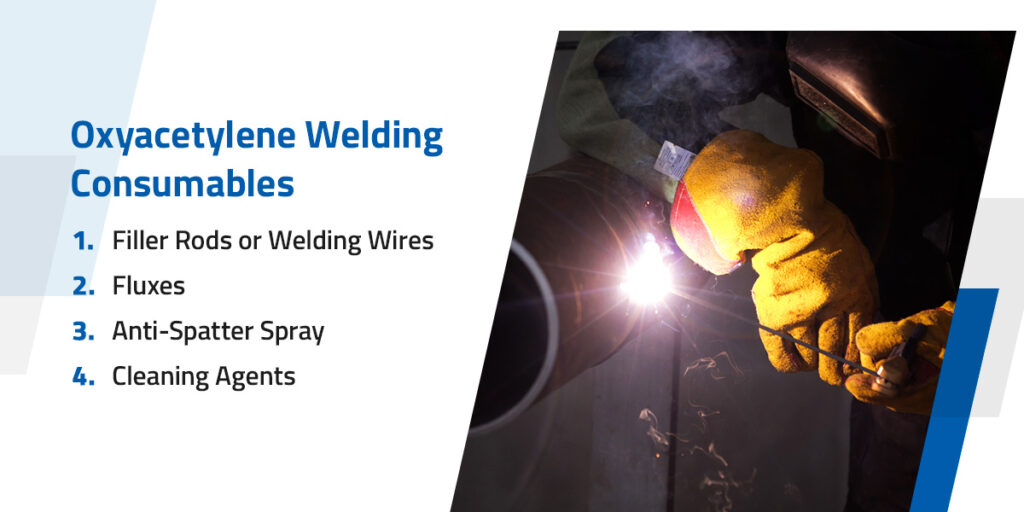
Here are examples of gas welding consumables:
Filler metals or welding wires are used to secure metal joints. They are available in different configurations, such as rods and reels. Filler rods require heat exposure to melt. As the electrical arc generates heat, it causes the filler metal to pool into a puddle or beads and warms the surface of the workpiece. Once melted, the liquefied filler metal flows between the cracks and edges, filling the gaps. As it cools down, the joints bond and form a stronghold.
Flux is a composition of organic and inorganic materials that perform different functions. Here are a few examples:
Anti-spatter spray prevents spatter from sticking to the welding table. This spray contains silicone or similar ingredients, typically water- or petroleum-based solutions. Anit-spatter spray makes cleaning easier and saves time.
There are various cleaning agents you can use to improve your work. One example is chemical welding cleaning agents like pickling paste, which effectively removes surface impurities like rust stains and heat tint scale. Mechanical weld cleaning is an inexpensive way of eliminating heat tint from stainless steel workpieces. Electrochemical weld cleaning is a relatively new technique, but is safe and effective.
It’s crucial to assess the potential hazards before starting any welding activity. There are standard types of equipment you need for almost every task. Here are some examples:
Ventilation is also essential to remove air contaminants and prevent the accumulation of flammable gases and oxygen-rich or -deficient atmospheres. You can use several ventilation strategies, including mechanical dilution, natural dilution and local exhaust ventilation.
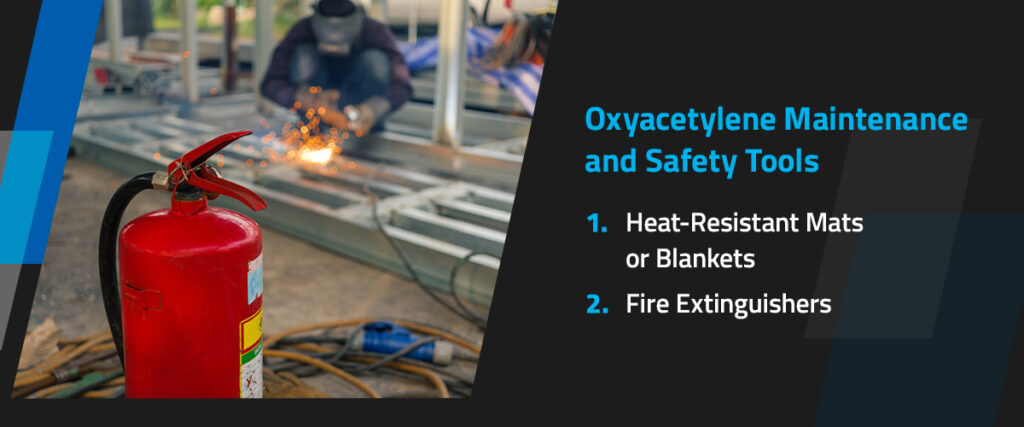
Here are some vital safety tools you need when gas welding:
Gas welding blankets are heat-resistant materials that protect other materials against sparks and spatter. A molten spark of spatter can damage furniture around the welding area and cause injury. You can avoid significant damage and keep workers safe with a good welding blanket.
There are different welding blanket materials, such as:
Fire extinguishers are necessary on every welding site to quench fires. There are different types depending on the kind of fire. The most common in welding shops are water-based fire extinguishers. They work by cooling the burning material and stopping the chemical reaction causing the fire.
Other fire extinguishers welders use are foam and dry chemical extinguishers. Foam extinguishers work similarly to water-based extinguishers but provide more insulation against heat, while dry chemical extinguishers smother the flames with a powered substance.
Other essential items include:
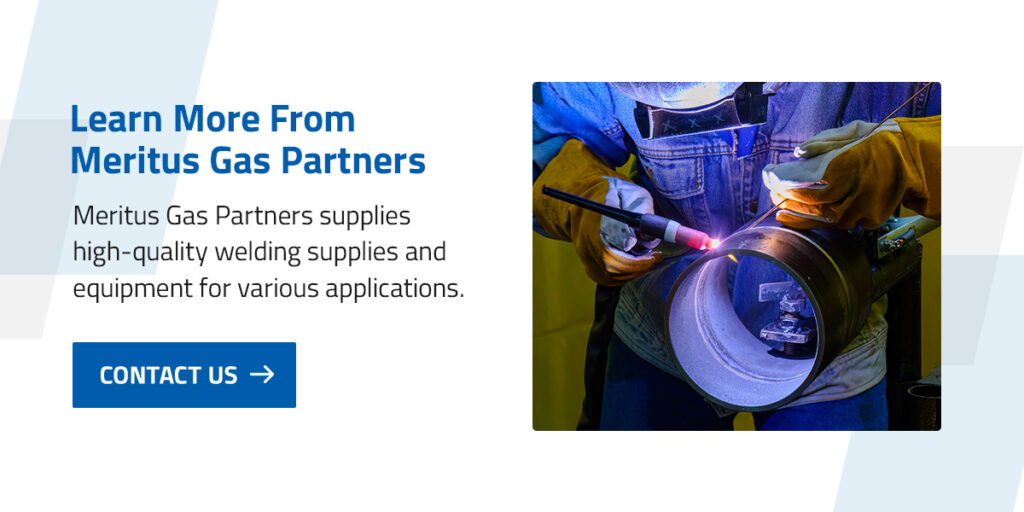
Meritus Gas Partners supplies high-quality welding supplies and equipment for various applications. We help customers stock inventory according to their needs and hold it locally for them. We also set up and repair equipment, giving you the convenience and time to focus on other essential parts of your welding process. We partner with top organizations to bring you the best products and services. Contact us now to learn more.